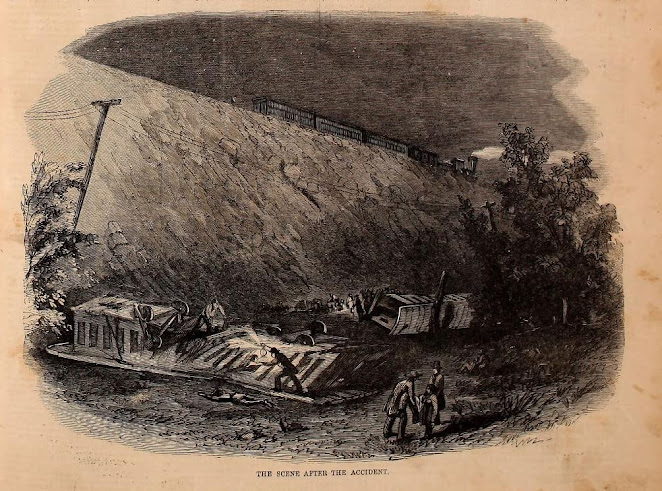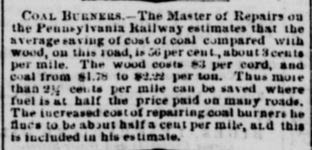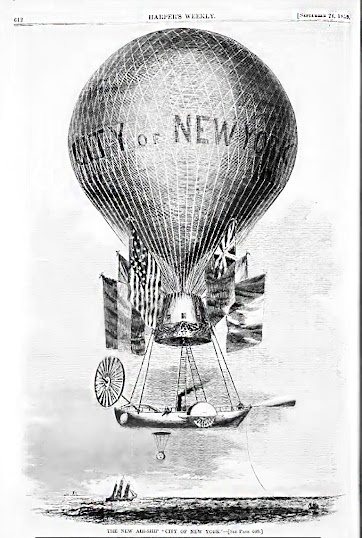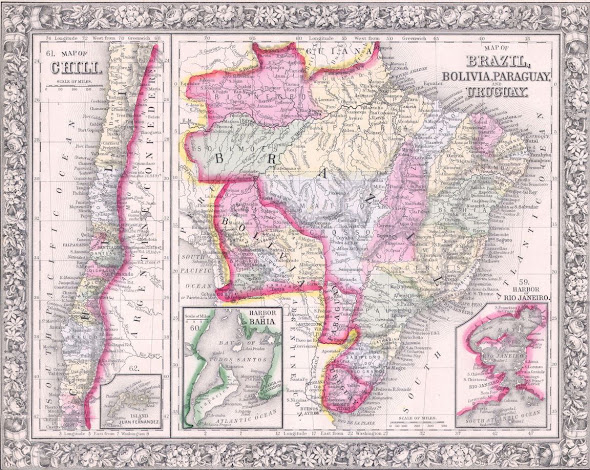Railroads--"Riding the Cars"
From Harper's magazine, Jan. 31, 1858
It's estimated over 7,000 people died in railroad accidents before the Civil War
Railroads--In the late 1830s and early 1840s, increasing numbers of wealthy men saw opportunity to join together to create a “rail road.” The earliest long rail line ran from Wilmington, NC to Weldon, NC on the Virginia border. Later, Weldon became a major transshipping point to carry slaves from the East to new owners in the Deep South.
Early locomotives were little more than a steam engine set on a flat wood surface with wheels attached to the bottom. The freight and passenger cars were simply open top boxes. Speeds varied from 10 to 35 mph. “Riding the cars “or “taking the cars” was the phrase for “ride the train” or “take the train.”
Smoke blew back on the engineer and passengers, sparks frequently burning holes in clothes. If it rained, let’s hope you brought your umbrella.
Soon, these cars had canvas tops applied to them and a cover for the engineer as well. Sparks from the smokestack burned holes in the awning, so an enclosed car using wood and iron was soon the standard. The engineer gained a wood or iron housing on the locomotive. After frequent bad derailments from hitting deer and cattle that had wandered onto the track the locomotives were outfitted with a “cow catcher,” the arrow shaped grate put on the front of all the locomotives.
Steamboat and packet boat companies joined with expanding railroads to publish coordinated schedules, advising passengers from parts of Virginia and North Carolina they could “ride the cars,” as taking the train was then called, assured they would arrive in Norfolk in time for supper and then to board an overnight packet boat to New York City or other points along the coast.
There was no standard gauge of track—that is, the gauge is the distance between the rails. It was not until after the Civil War a standard gauge of four feet 8 inches was agreed on. Before then, freight and passengers had to often change stations and trains to complete a trip. In fact, a gang of secessionists planned to assassinate Lincoln when he arrived in Baltimore on his way to Washington. Lincoln had to cross town to another train station to finish the trip. Lincoln’s train arrived at night and he was in disguise, so he went across town without being recognized.
Speeds increased a little bit. Derailments and collisions were common, not to mention boiler explosions.
A "train driver" as the engineers were then called, was interviewed by a newspaper. The reporter asked, "What's the chief skill required for your job."
"Knowing when to jump off," the engineer replied.
Derailed passenger cars could roll down steep hills and crash into rocks and trees or tumble from trestle bridges.
Still, as you can read below, the concept of corporate liability was still a new idea.
The Monetary Value of Life
There is sometimes a terrible railroad massacre; but upon the whole, when we remember how incessantly thousands of people are traveling in this country by day and night, the loss of life is very slight. Nor, when we remember how this country plunged into railroad enterprises when they were started, can we help feeling that, on the steam steeple-chase across the country, which every passage practically was, we have all been singularly preserved.
Yet the exposure , then and now, is the very reason why the railroad companies should be held to the heaviest damages in all cases of accident. Passengers have felt safe upon the New Haven Railroad since the Norfolk disaster, because the pecuniary damages allowed were so large that the Company found a few accidents would eat up the whole of the profit. Corporations have pockets, if they have no souls.
There is now pending a case in Boston which solaces the heart of the railway traveler. A certain Mr. Shaw was done to death on the Worcester Railroad, and his widow sued the Company. A verdict was rendered in favor of some $17,000. Thereupon a new trial. This time a verdict of $20,000. Thereupon another new trial. This time a verdict of $22,000 and now a motion for a third new trail. By all means, let it be granted, and suit proceed from trial to trial until the damages reach $50,000. Then let that be understood as the minimum sum which every railroad company must pay for every life lost; and the number as we cheerfully admit is already small, will become beautifully less.
As the means of travel increase in point of facilities and speed , so ought the safety. Mechanical improvement of every kind is very imperfect and unsatisfactory if it increases the comparative loss of life.
Train robberies became a new crime.
But the risks were worth it. Trains connected places with no navigable rivers. Travel took less time and shipping goods took less time and transported more than horse drawn wagons. Rail lines proliferated, soon making their owners wealthy, and public opinion began to paint them as robber barons.
When trains were not speeding along at 40 mph, they were stopped for as much as an hour to take on more wood—later, coal—and water for the steam engine. Once resupplied, it took a while to bring the steam pressure back up to start moving again. Resupply was frequent and this effectively cut the average speed back to ten to twenty miles per hour on long trips. Compared to a horse or coach at 3 to 5 five miles an hour (on a rare good road) and even slower speeds on steamboats going upstream, trains looked like lightning fast travel.
Foreshadowing the fates of small towns in the 1960s as the US Interstate highway system was laid out, towns by passed by railroads, withered while small towns such as St Louis, MO at the nexus of riverboat and train travel, quickly grew to be the second largest port in the United States by the 1850s.
Like steamboats, locomotives and passenger cars underwent rapid development, so trains not lost to accidents generally lasted only five years in service. Railroads touted their modern and more comfortable cars, so there was competitive pressure to keep up even if some equipment were still serviceable.
The introduction of coal as a fuel instead of wood, required a good bit of redesigning the locomotives. The locomotives with tall bell shaped smokestacks were for wood burners, which produced more sparks. The large bell shape smokestack contained more filters to cut down on sparks.
Novel Experiment in Locomotives—The great deliberation now a days in the matter of locomotives is to find the best and cheapest manner of obtaining the motive power. At the Boston locomotive establishment, Harrison Avenue, a twenty-two ton passenger locomotive is building as an experiment. In generation of steam in the engine the plan of Mr Latts in his steam engine, is adopted, that is, coils of pipes are placed one atop the other, which contain the water, and upon which pipes the fire is directly brought. It is intended to burn coal and it is thought steam can be made in ten to twelve minutes while in other locomotives it requires a much longer period of time. Another novelty is the engineer is placed ahead of the smoke pipe, and he will have uninterrupted view of the road before him. The fireman is to be placed behind the boiler.
It is stated that whether the idea of burning coal in this engine succeeds or not, wood can be used at half the running expense of other locomotives. The engine will be ready in a month or two when experiments to test the value of the improvement will be made.
“COAL BURNERS—The master of repairs on the Pennsylvania Railway estimates that the saving of cost of coal compared with wood on this road is 50%, about 3 cents per mile. The wood cost $3 per cord, and the coal from $1.78 to $2.22 per ton. Thus more than 2.5 cents per mile can be saved where fuel is at half the price paid on many roads. The increased cost of repairing coal burners he feels to be about a half cent per mile and this is included in his estimate.”
Methods of ticket sales were haphazard and consigning freight was almost as much so—one railroad advertised it would no longer pick up unlabeled freight left beside the tracks.

PARISEN & KING’s STEAMSHIP EXPRESS PER ROANOKE and
JAMESTOWN-Reduced Rates, Increased Expidition &c---The proprietors having
made new arrangements for the still better dispatch of their Express by the
steamships “ROANOKE” and “JAMESTOWN” from New York, they wish to keep it before
the public, that ARISEN & KING’S POPULAR SOUTHERN EXPRESS is always on
hands for the accommodation of their friends, at the lowest rates and
unparalleled dispatch—their express leaving New York, is generally delivered at
almost any point of Virginia in 48 hours and throughout North Carolina 56
hours, and a forty percent below the old humbug monopoly.
PARISEN & KING’S facilities for the expeditions
transportation of Freight and Packages cannot be beat by any Express Company in
existence and they defy any competition, therefore, in the shape of humbug,
imposition, and monopoly.
Be sure to order your goods by PARISEN & KING’S
Express, 2cnd Barclay Street, New York.
Rest assured, that all they promise, they will faithfully
fulfil!!
PARISEN & KING, 2cd Barclay st. N.Y.
And Bollingbrook st., Petersburg, Va.
AGENTS
The ad then goes on to list agents in six cities in
Virginia and 13 in North Carolina
NOTICE—Express packages for Norfolk, Petersburg, and
Richmond and the interior, intended for shipment per steamships ‘Roanoke” and
“Jamestown,” will hereafter be received by MESSRS. PARISEN & KING, 2nd
Barclay Street, New York, who are the only authorized Agents to forward our
Express by those steamships to VIRGINIA, NORTH CAROLINA, and TENNESSEE.
June 13, 1853

















Comments
Post a Comment